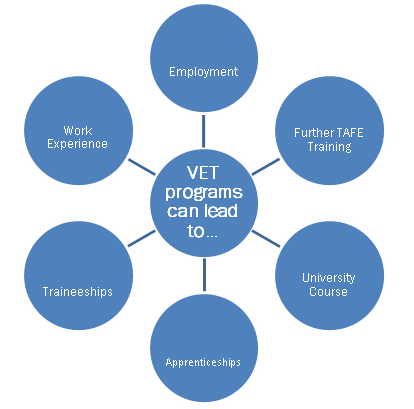Vocational Education and Training (VET) enables a secondary student to combine education with training to provide occupational or work-related knowledge and skills.
Features of VET programs
- Focuses on students developing industry specific and workplace skills.
- Generally completed during Years 11 & 12 however some schools allow students to start a VET program in Year 10.
- Training is one day per-week either in a morning or afternoon or for some programs all day. VET training usually occurs on a Wednesday however this will vary with some programs.
- Training is usually held at a TAFE or a smaller training venue. In some cases it may be held at a school or a workplace for some of the time.
- Students can complete a VET program as part of their VCE or their VCAL senior school certificates.
- Prepares students to the standard expected from employers and industry.
- Student’s receive a Certificate acknowledging completion of a nationally recognised training course.
- A VET program is like any other VCE subject or VCAL stream

Benefits of VET programs
- They assist students to become ‘job ready’ thereby increasing their employment prospects.
- They form part of recognised pathways to further education and training.
- Upon successful completion, students receive a nationally accredited qualification.
- They contribute to the eligibility requirements for both VCE and VCAL.
VET in VCE
On successful completion of a VET program, students are eligible for credit of up to four units on the VCE Statement of Results. Two units are deemed to be at unit 1-2 level and two at 3-4 level. Students receive credit towards completion of their certificate as well as the nationally recognised certification (where available) or they can complete further assessment to obtain a study score.
A Study Score is available for a number of VET programs. Students wishing to obtain a study score will need to complete:
- School-Assessed Coursework – a set of coursework tasks set by the assessor throughout the training year
- An examination set by the VCAA (Victorian Curriculum and Assessment Authority)
Where VET programs don’t have Scored Assessment students will receive one ATAR increment
Block Credit -Students with full or partial completion of a nationally recognised Vocational Education and Training or Further Education (VET/FE) qualification may be eligible for credit towards their VCE. Students are eligible for credit if they have completed, or are completing, training in a nationally recognised VET/FE qualification/s that is not included in the suite of approved VCE VET and Australian School Based Apprenticeships and Traineeships programs.
Complementary VCE Units
There are no pre-requisite units of study required for VET programs, except where units 1 and 2 must be completed to enrol in units 3 and 4. Students should consult with their VET/VCAL or Careers Coordinator
VET in VCAL
Successful completion of a VET in Schools program allows VCAL students to gain credit in the VCAL Certificate in either the Industry Specific Skills strand or the Work Related Skills strand. The credit may be at Foundation, Intermediate or Senior level.
It is important to note VCAL students undertaking an Intermediate or Senior Level Certificate must undertake a VET program to meet the minimum VCAL course requirements of the Industry Specific Skills strand.
